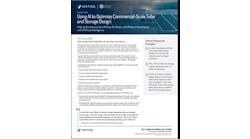Microgrids and distributed energy resources (DER) can help Texas grapple with climate-induced extreme weather outlined in a new report that calls on state policymakers to better prepare for electricity disasters like February’s Winter Storm Uri.
Uri knocked out power to two out of three Texans and shut off water to nearly half. The Texas Department of Public Health linked 210 deaths to the deep freeze.
And now a study from the Texas State Climatologist, Texas A&M University, and Texas 2036 predicts the weather is only going to get more extreme in the state.
“Assessment of Historic and Future Trends of Extreme Weather in Texas, 1900-2036” found that by 2036, the number of 100-degree days could nearly double compared to the number the state experienced between 2001-2020. By 2036, average temperatures will increase by 3 degrees above the average that occurred between 1950 and 1999. Heavy rains, drought and wildfires are expected to worsen.
Texas needs a microgrid roadmap
“This study highlights that Texas, like every state in their own way, is vulnerable to extreme weather events and other disruptions that can have dramatic impacts on an electric grid that is brittle,” said Cameron Brooks, executive director of Think Microgrid, an advocacy and education group and an affiliate of Microgrid Knowledge.
Planning for and building resilience requires that policy makers take action, he added. For Texas and other states, the first step is to develop a roadmap to address the challenges of extreme weather.
“The Texas PUC (Public Utility Commission of Texas), on their own authority or directed by the legislature, can begin the process of mapping out where microgrids could be deployed across the state to maximize the resiliency they provide the grid and the Texas economy more generally,” said Brooks.
The Texas electricity market has unusual characteristics and an open market that creates challenges for microgrid developers seeking to gain access to the market in order to finance and operate projects, he said.
“This can introduce complexities that prevent integrating resiliency into the Texas energy market,” Brooks said.
PUC considering market redesign
The extreme winter — and concerns about the state’s notoriously hot summers — are causing a re-examination of the state’s electricity system and markets.
Shortly after the report was released, a group of energy experts participated in a teleconference focusing on a PUC effort to draft market redesign recommendations and address these concerns (Project No. 52373).
“The potential cost of a major electricity system failure is so high we need to be thinking about building a whole suite of resources and rules that provide layers of protection for Texans going forward,” said Suzanne Bertin, managing director, Texas Advanced Energy Business Alliance (TAEBA) during the teleconference.
DERs represent one of those layers. A TAEBA-commissioned 2019 analysis concluded that Texas electricity customers could save about $5.47 billion over the next 10 years deploying DER to reduce peak power generation and transmission and distribution investments.
“So far, customer-based solutions have been ignored but are key,” Bertin said, noting that regulatory barriers prevent full deployment of options such as rooftop solar, batteries and electric vehicles.
Three-phased market improvement
Meanwhile, a group that includes numerous TAEBA members submitted to the Texas PUC comments calling for a phased approach to market redesign. That would involve beginning with a “no-regrets,” low-hanging fruit approach — shifting revenue away from crises and investing revenue in resources that respond to system needs, for example.
A second phase would encourage work on projects that allow for new supplies and demand management options, including evaluating new ancillary services and “fixing” distribution interconnection rules for DERs.
A third phase would focus on new studies and analyses of longer-term market measures, including reliability standards, according to the comments, whose 24 signatories included Concentric, Enchanted Rock, OhmConnect, Sunrun, and Voltus.
The market design changes aim to avoid repeats of the electricity system failure Texas experienced in February due to extreme weather.
Weather report takes new approach
“It is up to Texans, both individually and collectively, to decide what level of resilience is appropriate, and at what cost, compared to the costs of damage and recovery on both an economic and societal level” — Assessment of Historic and Future Trends of Extreme Weather in Texas, 1900-2036
Extreme rainfall events will get worse, leading to as much as 30% to 50% more than Texas experienced between 1950 and 1999. And while the numbers of hurricanes are expected to possibly decrease, their intensity will increase. In addition, because of sea level rise, the risk of hurricane storm surges may double in some areas by 2050 compared to 1900, according to the Texas weather assessment report.
Also expected are more severe droughts and higher risks of wildfires in the future.
The report calls on residents and leaders to prepare for extreme weather.
“The future of Texas depends on its resilience to the natural hazards of the future. It is up to Texans, both individually and collectively, to decide what level of resilience is appropriate, and at what cost, compared to the costs of damage and recovery on both an economic and societal level,” said the report.
The report differs from many climate-related studies, said John Nielsen-Gammon, Texas State Climatologist for the Department of Atmospheric Sciences, Texas A&M University.
Most projections about future climate conditions are based on climate model projections, but many people don’t trust those models. The report took a different approach and focused mainly on historical weather trends, which can be caused by natural variability and climate change, he said.
Graph courtesy Texas A&M University
Microgrids = resilience + climate solution
Mark Feasel, president, Smart Grid North America, Schneider Electric, said that the report is the latest confirmation that climate change is yielding extreme weather events — and that microgrids can help.
“The approaching cold season reminds residents of the dire need for preparedness and resilience, especially with the recent winter weather event in Texas earlier this year still fresh in memories,” he said. (More than two out of three (69%) Texans lost electrical power at some point during Winter Storm Uri in February for an average of 42 hours and almost half (49%) lost running water for an average 52 hours, according to the Hobby School of Public Affairs.)
The report’s data, along with microgrid digitalization, will help decision makers view weather data in the context of events such as outages, he said. And that can help protect communities from outages and help move Texas toward a more sustainable energy future.
Unfortunately, companies often use diesel or gas backup generators during outages, which he said aren’t economical or sustainable solutions. It’s time to move away from that option, Feasel said.
“Microgrids can provide resilience during outages while fighting climate change by reducing carbon emissions. By leveraging diverse forms of DERs such as solar PV, combined heat and power, wind, and battery storage, microgrids can complement the existing infrastructure providing sustainable energy to protect communities and the environment,” said Feasel.
Texas grocery store unaffected by a surrounding power outage thanks to a microgrid installed by Enchanted Rock. Photo courtesy of Enchanted Rock
Support ethos of competition, choice
To help solve Texas’s electricity challenges, the Texas PUC is expected to pick a few favorite technology options, said Alison Silverstein, an energy consultant and former senior advisor at the Texas PUC and Federal Energy Regulatory Commission during the teleconference.
“We are hoping that they look for performance-based technology neutral solutions rather than favoring fossil plants,” she said, adding that fossil-fuel plants may be needed in the short term.
“We’re looking for solutions that will be consistent with the Texas ethos of competition and markets and customer choice and empowerment rather than looking for a centralized planned command and control approach,” she said. That would mean focusing on energy efficiency, demand response, storage and demand side resources like storage and solar.
Silverstein hopes that the PUC won’t try to load extra costs on Texas’s booming renewable generation industry, which would look discriminatory and would likely fail in court. Such a move would shift costs enough to put some existing renewable energy companies in Texas out of business, she said.
“The alternative is to find ways to share the cost of reliability so that they are super effective and spread them on all customers in a more equal fashion,” said Silverstein.
Danger of a collective shrug
It remains to be seen how much state regulators will incorporate microgrids into new rules and policy.
But it’s critical to take action and not become accustomed to climate-change driven, disruptive and dangerous weather crises, said industry observers and teleconference participants.
“We’ve become far too accustomed to these extreme weather events to the point where we react with a collective shrug. We shouldn’t. We should be demanding that policy makers lead and take proactive steps to align private capital and public policy goals around resilience,” said Brooks.
Interested in microgrids? Subscribe to the free Microgrid Knowledge Newsletter.








